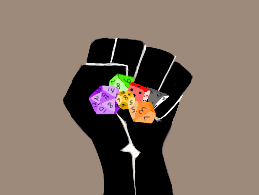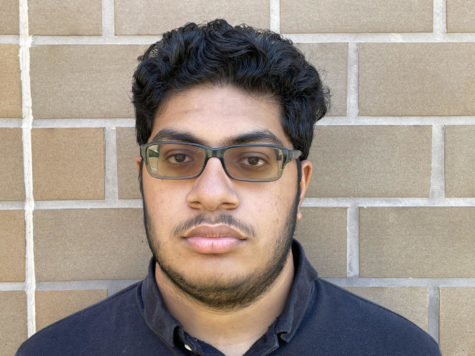The history of negative stereotypes within Dungeons and Dragons

Racial stereotypes in Dungeons & Dragons characters can have far-reaching effects.
February 9, 2021
A party of first-time adventurers is traveling across the land. Their latest quest is to remove a drow encampment. The Dungeon Master (DM) describes how the angelic Aasimar has been viciously attacked by these mysterious demon-worshipping savages. As the rogue sneaks into the drow settlement, the player controlling the rogue makes an awkward realization. The party has been sent by what the DM described as noble messengers from heaven to attack a supposedly pure evil group comprised solely of people with all black skin.
Do you see the problem here?
Recently, Dungeons and Dragons (D&D) has come under scrutiny due to increasing cries for racial equality. D&D is a role-playing game where a DM guides a party of adventurers through one of many fantasy worlds filled with a wide variety of fantasy beings (referred to as races) like elves, dwarves, orcs, etc. that accompany humans. However, as the game has grown dramatically in popularity over the last five years and because of calls for racial injustices to be corrected, the community has had to confront the history of fantasy races and how they’ve often negatively coded real-life peoples and cultures.
This racial coding present in D&D can be traced back to the works of J.R.R Tolkien, the author of the Lord of the Rings trilogy and the Hobbit. In these books, a common enemy to the protagonists are orcs, an aggressive, green-skinned species who were originally elves, but corrupted and twisted. Their appearance was reminiscent of East Asian caricatures, as described by Tolkien himself.
“Squat, broad, flat-nosed, sallow-skinned, with wide mouths and slant eyes: in fact degraded and repulsive versions of the (to Europeans) least lovely Mongol-types.” J.R.R Tolkien said in a private letter published in “The Letters of J.R.R Tolkien” (1981).
When the first edition of D&D was released in 1974, most of its fantasy elements were taken from various works like Tolkien’s. As it grew throughout the 80’s and 90’s, it added unique creatures like kobolds, beholders, and displacer beasts. However, some of these creatures mimicked certain negative racial biases or stereotypes. For example, the drow, otherwise known as the Dark elves. Contrasted with most elves who have pale to tan skin, the drow have black skin and are presented as a monoculture of cultist invaders who enslave entire towns and cities.
The issue of negative racial coding in Dungeons & Dragons has persisted even into the 2010s. The adventure book “Tomb of Annihilation” is an adaptation of multiple D&D novels and modules from the ‘90s. These works originally included the city of Metro, which was described as on the border of the “savage coast.” of the Chult Peninsula. In the original storyline, the city was a former trading post that collapsed, and the only remaining human life left in the city was described as savage cannibals depicted as exclusively Black. When revisiting Chult, Wizards of the Coast, the owners of D&D, tried to remove these negative stereotypes by having Mezro be replaced with the thriving city of Port Nyanzru. This was supposed to represent the native Black population freeing itself from the occupation of colonists. However, this city was an amalgamation of several unique African cultures simplified into a one-dimensional, stereotypical civilization. Chult combined West African Voodoo beliefs, South African click-based languages, and East African clothing and presented it into a singular identity. If European culture was treated like this in media, you would see a man with a french accent wearing Russian clothing while participating in a Spanish Folk dance. These are all different cultures that are treated as distinct from one another, and it should be no different from African ones. It’s important to note that of the writers of “Tomb of Annihilation”, not one of them was Black.
“To me, it did not feel offensive. I felt lazy. There’s so much more to be done. There are huge bodies of work in African fantasy.” Leslie Higbee Light, writer for the website Black Nerd Problems said in an interview with Cecilia D’Anastasio of Kotaku Magazine. “If you’re gonna invest in me as a player, give me something I’d never thought of.”
However, there have been attempts to rectify these stereotypes. In Dungeons and Dragons, there are many different worlds, and despite the Forgotten Realms being the standard-setting, not all of them follow in its footsteps. For example, the worlds of Eberron and Exandria depict various different societies and ideologies with individual members being able to act freely and not according to a singular mindset rather than being stereotyped as a monolithic group of savages and/or evildoers. In Eberron, rather than having a singular drow or orc culture, there are multiple different ones who have different traditions and customs, along with different goals and mindsets while in Exandria, there is no standard at all for how any fantasy being acts.
“We present orcs and drow in a new light in two of our most recent books, Eberron: Rising from the Last War and Explorer’s Guide to Wildemount. In those books, orcs and drow are just as morally and culturally complex as other peoples. Wizards of the Coast declared in an official statement on June 17, following large scale protests over the killing of George Floyd.
“We will continue that approach in future books, portraying all the peoples of D&D in relatable ways and making it clear that they are as free as humans to decide who they are and what they do.”
A negative depiction of any group of people in media can result in stereotyping and promoting harmful views on said group. The problem shown here arises when there is a lack of diversity in media. With current calls for racial equality, it’s now more important than ever to represent these voices and ideas all across the board.




